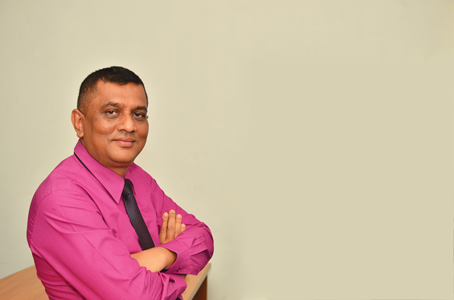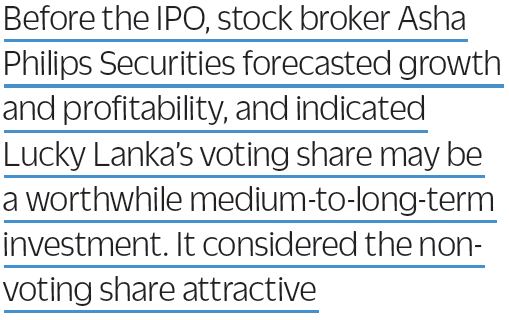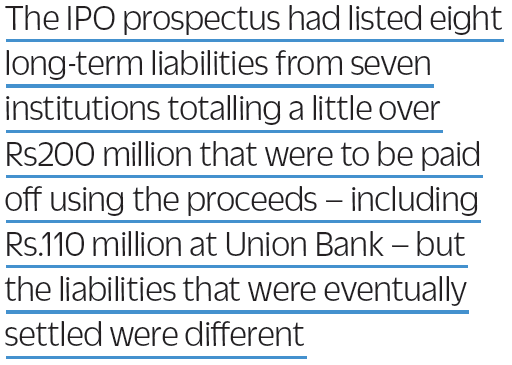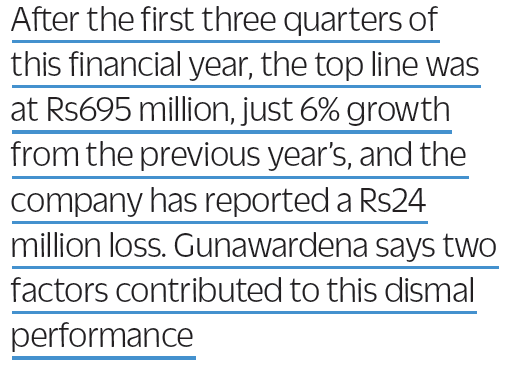

Lucky Lanka's Post-IPO Troubles
It is now reporting a loss, and its share price has come down 30% since its listing. What went wrong for Lucky Lanka? It’s the stuff of business legend: a man barely out of his teens from Kamburupitiya, Matara starts a milk processing business with one cow and a bicycle. Twenty-three years on, that firm’s revenue is touching […]
It is now reporting a loss, and its share price has come down 30% since its listing. What went wrong for Lucky Lanka?
It’s the stuff of business legend: a man barely out of his teens from Kamburupitiya, Matara starts a milk processing business with one cow and a bicycle. Twenty-three years on, that firm’s revenue is touching a billion rupees and has just gone public following an Initial Public Offering (IPO). But suddenly the company’s luck seems to have changed. Since Lucky Lanka’s IPO in July 2014, it has seen its profits plummet, and the share price has also slipped from IPO levels. The company posted a Rs13 million profit before tax in the financial year before the IPO but, in the nine months ending December 2014, losses topped Rs24 million. During the same period the previous year, the company’s profit was Rs12 million.
 Lucky Lanka had three objectives for the IPO capital: settling a chunk of long-term loans, expanding its factory and funding a marketing initiative to popularise fresh milk. Before the IPO, stock broker Asha Philips Securities forecasted growth and profitability, and indicated Lucky Lanka’s voting share may be a worthwhile medium-tolong-term investment. It considered the non-voting share attractive.
Lucky Lanka had three objectives for the IPO capital: settling a chunk of long-term loans, expanding its factory and funding a marketing initiative to popularise fresh milk. Before the IPO, stock broker Asha Philips Securities forecasted growth and profitability, and indicated Lucky Lanka’s voting share may be a worthwhile medium-tolong-term investment. It considered the non-voting share attractive.
However, not everything around the IPO proceeds use has gone to plan. A conflict with a bank has delayed settlement of an important liability, IPO-funded factory expansion has been delayed and a marketing campaign to convince Sri Lankans to drink more fresh milk isn’t translating to an immediate sales gain. As a result, the company has reported a loss in the half year since the IPO and its share price has taken a beating. The voting share is currently down 30% from the IPO price, while the non-voting share is down 27%. The oversubscribed IPO raised Rs300 million in new equity, and demand for shares exceeded Rs453 million. The IPO offered 38 million voting shares at Rs6 each and 24 million non-voting shares at Rs3. Lucky Lanka’s main objective for raising capital was paying back Rs200 million in high-interest-bearing liabilities, including Rs110 million from Union Bank.
 In the 2014 financial year, Lucky Lanka’s debt servicing cost Rs.66 million, more than three times its net profit. At the end of 2014 – six months after the IPO – the company’s interest-bearing long-term borrowings stood at Rs101 million, only a slight drop from the Rs112 million at IPO time. Lucky Lanka provided Echelon a list of liabilities totalling Rs213 million it had settled with 18 entities using the IPO proceeds.
In the 2014 financial year, Lucky Lanka’s debt servicing cost Rs.66 million, more than three times its net profit. At the end of 2014 – six months after the IPO – the company’s interest-bearing long-term borrowings stood at Rs101 million, only a slight drop from the Rs112 million at IPO time. Lucky Lanka provided Echelon a list of liabilities totalling Rs213 million it had settled with 18 entities using the IPO proceeds.
This was the same list Lucky Lanka had presented to the Colombo Stock Exchange, when it requested the company to explain how the IPO proceeds had been utilized. The IPO prospectus had listed eight long-term liabilities from seven institutions totalling a little over Rs200 million that were to be paid off using the proceeds – including Rs.110 million at Union Bank – but the liabilities that were eventually settled were different. A little less than Rs.60 million has been settled at Union Bank; the liability at this bank is a combination of several loans obtained at different times.
In a pre-IPO note, stock broker Asha Philips Securities estimated that Rs200 million worth of debt retirement would cut Lucky Lanka’s interest costs by 81% in the 2015 financial year, leading to the overdraft utilization being relaxed by about 30% amid improved cash generation, supported by interest cost savings. The stock broker expected Lucky Lanka to bear a total financial cost of just Rs13 million for the 2015 financial year. However, the finance cost for the first nine months ended December 2014 was Rs40 million.
Chairman Lal Keerthi Gunawardena explains that several factors contributed to this. Although the IPO was held in July, the proceeds did not reach the company until a couple of months later, and it was well into the third quarter by the time they were utilized to settle some liabilities. Further, the company was unable to fully settle its Rs110 million Union Bank liability, as the bank wanted the facility restructured. Gunawardena says that, while this restructuring was progressing, the bank made a massive interest charge, which inflated the company’s financial costs for the period. The company is contesting this interest charge with Union Bank. Lucky Lanka’s principal place of business, its Kamburupitiya factory, is located on land mortgaged to the bank.
Gunawardena says that Lucky Lanka began to fully benefit from the almost Rs213 million liability settlement in January 2015, the fourth quarter of its financial year. The results for the final quarter ending March 2015 are still unavailable, but the Chairman says that the company’s monthly interest burden has fallen to a third of the Rs6 million it booked monthly during the first nine months of the financial year.
Gunawardena was just 20 when he started Lucky Lanka with his sisters’ support in 1991, using the excess milk of the household’s cow. Today, the company collects fresh milk from over 5,000 farmers, mainly in Uva Province, to manufacture value-added products at its Kamburupitiya factory and distribute to its island-wide network. The company also distributes some fresh milk. Lucky Lanka employs 400, and its factory has capacity to produce 20,000 litres of value-added milk products daily.
 In its pre-IPO note, Asha Philips estimated Lucky Lanka was the third largest player in yogurt, with 17% market share. At the time of the note’s publication, Lucky Lanka’s monthly production averaged five million yogurt units, while market-wide monthly consumption was thirty million. The second objective for the IPO proceeds was investing Rs75 million to expand its production plant, including a new cold room complex and ammonia refrigeration system, extend the existing UHT milk processing building and purchase new machinery including conveyer and pigging systems. Lack of cold storage was a bottleneck to utilizing its full potential capacity of 30,000 litres of daily production. Asha Philips expected Lucky Lanka to use half of this incremental capacity in the 2015 financial year and 100% in the following year, and combine this with 5% growth in industry consumption to increase its market share.
In its pre-IPO note, Asha Philips estimated Lucky Lanka was the third largest player in yogurt, with 17% market share. At the time of the note’s publication, Lucky Lanka’s monthly production averaged five million yogurt units, while market-wide monthly consumption was thirty million. The second objective for the IPO proceeds was investing Rs75 million to expand its production plant, including a new cold room complex and ammonia refrigeration system, extend the existing UHT milk processing building and purchase new machinery including conveyer and pigging systems. Lack of cold storage was a bottleneck to utilizing its full potential capacity of 30,000 litres of daily production. Asha Philips expected Lucky Lanka to use half of this incremental capacity in the 2015 financial year and 100% in the following year, and combine this with 5% growth in industry consumption to increase its market share.
However, capacity expansion hasn’t been done yet. The company has put this expansion on hold to embark on a new venture partnering a Czech Republic-based firm for cheese-making. The proposal had included setting up a brewery, which Lucky Lanka has declined, but it has joined the cheese-making effort. The Czech company wanted to establish the new venture’s factory in Tangalle, but Gunawardena proposed the use of a Lucky Lanka-owned 4.5 acre land adjoining its Kamuburupitiya factory, as the new company could utilize the firm’s existing resources, such as its distribution channels, boilers and electricity. The European company has agreed to this.
The company is about to construct a building on the land, and Gunawardena is in discussion with one of the Czech company’s partners to buy cheese-making machines. He says that, in the past, Lucky Lanka never aimed for large profits, but focused on returns that provided a reasonable standard of living for its owners. “But, since we’re a public company now, we somehow have to make a profit,” he says. “I’m wondering how. It’s hard to make a profit doing real business in Sri Lanka while protecting the values of the industry and of the country. So we’re looking at cheese, because somehow we need to make money. We have to give something to our shareholders.”
The IPO’s third objective was to invest Rs25 million to implement new projects like the “Gedarata Kiri” programme, milk bar outlets and school canteens. The programme promotes fresh milk as an alternative to powdered milk, which is mostly imported. The company launched this programme in late 2014. It started establishing milk bars, which provide products like hot milk, fresh fruit juices and yogurt including outlets at both entrances of the Southern Highway. The company intends to establish 1,000 such outlets island-wide under franchising agreements. Asha Philip had high expectations for Lucky Lanka’s fresh milk initiative. In its pre-IPO note, it stated that Lucky Lanka then had 5,000 litres of daily fresh milk capacity, with a 95% utilization rate in Matara and that the company would enter the Colombo market by August 2014, adding 5,000 litres daily capacity, and then replicating this in Kandy with 4,000 litres daily capacity. Asha Philip expected close to 100% utilization of this additional 9,000 litres due to Lucky Lanka’s forecast price of Rs100 per litre being lower than the cost for powdered milk and for then available fresh milk in the market and due to improved consumer accessibility via milk outlets. Forecasting a conservative 85% utilization rate for the 2015 financial year, the stock broker expected liquid milk sales to contribute 37% to total revenue and overall revenue to grow by more than 15%.
However, the company is finding that promoting fresh milk is tougher than first thought, as its success depends on changing the thinking of a whole society. Powdered milk has been established in Sri Lanka for decades. “Around the world, fresh milk is sold as it is,” says Gunawardena, lamenting that in Sri Lanka, people depend on milk powder or supermarket packaged milk. In its fresh milk initiative, Lucky Lanka uses its already established distribution network to transport fresh milk from areas like Welimada to distribution centres in Matara, Galle and Colombo. It has also established 50 litre milk tanks in several retail locations from which consumers can purchase milk by the litre or bottle. “Still, it is very difficult,” says Gunawardena. “The habit of drinking powdered milk is hard to change. We had a very big advertising campaign, but it’s difficult to change the minds of the people.”
 With Asha Philip’s expectation of an 81% cut in Lucky Lanka’s interest costs due to its Rs200 million worth liability settlement and the accelerated 15% revenue growth, the stock broker expected the dairy company to piggyback on its IPO proceeds to see its revenue topping a billion rupees and profit before tax hitting Rs74 million for the 2015 financial year. What has actually transpired has been a far cry from this scenario. After the first three quarters of this financial year, the top line was at Rs695 million, just 6% growth from the previous year’s, and the company has reported a Rs24 million loss. Gunawardena says two factors contributed to this dismal performance.
With Asha Philip’s expectation of an 81% cut in Lucky Lanka’s interest costs due to its Rs200 million worth liability settlement and the accelerated 15% revenue growth, the stock broker expected the dairy company to piggyback on its IPO proceeds to see its revenue topping a billion rupees and profit before tax hitting Rs74 million for the 2015 financial year. What has actually transpired has been a far cry from this scenario. After the first three quarters of this financial year, the top line was at Rs695 million, just 6% growth from the previous year’s, and the company has reported a Rs24 million loss. Gunawardena says two factors contributed to this dismal performance.
First, the weather; it rained heavily in 2014 in comparison to previous years, and Sri Lankans consume much fewer dairy products in rainy weather, as per Gunawardena. He says that it was only in the final quarter of the 2015 financial year that the company was able to achieve its targets. The second reason was increased competition in the market following Lucky Lanka’s much-publicized IPO. “We faced a big campaign,” he says. “The multinationals thought we were getting strong and that we’ll get established because of this IPO. Then they put their maximum effort to the market. They’re giving free of charge. Some yogurt is selling at Rs19 while we’re selling at Rs25. They’re undercutting. They increase their free issues, they give discounts, especially in the supermarket. This is to discourage us.”
Gunawardena says that the company went for an IPO because he wanted to stabilize it. He still owns 53% of the company and has big ambitions. He intends to not only sell dairy products, but change Sri Lanka’s milk drinking habits. He will continue with his fresh milk initiative, and also has another ambitious plan to establish a national policy of standardization of school canteens. This plan will introduce safe, nutritious food for school children and enhance school canteen quality through a standardization process.

